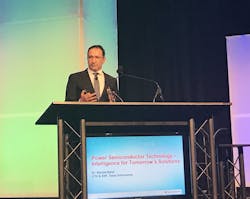A can’t-miss event at APEC are the plenary sessions where power electronics experts share their extensive knowledge through different presentations. This year, session attendees got a better idea of where power electronic is heading as well as updates on the latest advances in some technology trends.
Dr. Ahmad Bahai from Texas Instruments kicked off the plenary sessions by looking at the trends that are pushing power electronics into the forefront of research and development. Innovations in energy and power management, for example, are happening at a very rapid pace. Technology advances can be seen throughout the energy sector in applications ranging from energy generation to energy storage. As these technologies evolve, the power semiconductor industry is trying to keep up with the high demand of smart and high-efficiency power management systems.
Texas Instruments' Dr. Ahmad Bahai discusses the future of power electronics at APEC 2017 plenary session.
Dr. Bahai predicts that the semiconductor market will grow consistently and quickly in the next two years. In 2005, 30% of the energy of the United States went through some kind of semiconductor device. By 2030, 80% of energy will travel through a semiconductor device, giving the power semiconductor industry an unmatched opportunity to evolve and grow.
In recent years, energy storage solutions have expanded from automotive to residential storage solutions. As data centers consume more power, there are opportunities to improve efficiency by not having loads connected 24/7. In addition, dc current is having a comeback as more power electronics are powered by dc current and run in low power. Therefore, the “war of the currents” may not be over, as more techniques are now available for converting direct current to higher/lower voltages for instance. As the electrical grid gets smarter and the electrification of automobiles becomes a reality, bi-directional power electronic devices are finding wider applications such as in vehicle-to-grid applications.
In terms of new power semiconductor materials, gallium nitride (GaN) and silicon carbide (SiC) are increasingly used in power systems. In many applications, they perform better than silicon devices, which make them more suitable even at a higher cost. Among the benefits of these process technologies are better density and efficiency.
Beyond examining the world of power electronics and its trends, Dr. Bahai gave the audience a chance to think about the future possibilities and applications for power electronic technologies. Energy technology is going through a revolution similar to data technology. If President Trump’s agenda for America’s infrastructure regeneration is a success, we will see major changes in the energy sector that will directly affect the evolution of the power semiconductor industry.


